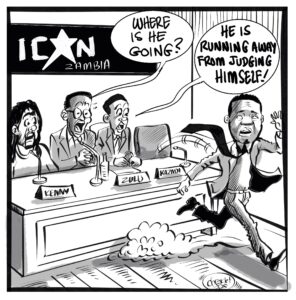In Zambia, major economic decisions are made by the President at State House and not at the Ministry of Finance, says Norway’s last serving Ambassador to Zambia Arve Ofstad.
And Ofstad has warned that Zambia should be careful with Chinese debt because it lacks transparency and is usually shrouded in corruption.
Meanwhile, Ofstad says Norway refused to be part of the 750 MW hydropower station at Kafue Gorge Lower project which was considered not to be transparent.
In a CHR Michelsen Institute (CMI) Insight paper for June 2019 titled “Zambia’s looming debt crisis – is China to blame?” authored by Ofstad and Elling Tjønneland, the duo observed that Zambia was in its current economic situation partly because decisions were dictated by State House under various political pressures.
“In Zambia, however, major economic decisions are primarily made in the Office of the President (often just described as “State House”), rather than in the Ministry of Finance. While the state budgets presented to Parliament make reasonable sense and highlight priorities and good financial management, the President and his advisers, under various political pressures, decide on actual spending. This became very clear under President Sata and has more-or-less continued under President Lungu. Former Finance Minister Chikwanda may have found borrowing to be the easy way out, rather than opposing the President’s expenditures. In addition, even though all state-guaranteed loans in principle should pass through the Ministry of Finance and be approved by Parliament, this has not always been the case. The more recent Finance Minister Felix Mutati and the current Minister Mwanakatwe may have been trying harder to control the economy which is drifting into a heavy debt dependency. It remains to be seen how Mwanakatwe will manage,” read the paper.
Ofstad and Tjønneland warned that Chinese debt was dangerous due to lack of transparency.
“China has tried to present itself as a donor that is different from the Western and multilateral donors and development funders. They claim that they provide grants and loans for development purposes without political conditions and that their terms are more beneficial. They claim to be on more “equal terms” since China is also a developing country. However, China is also less transparent in its finances and aid, and these challenges are apparent in Zambia. It is difficult to obtain information about the actual figures and the full terms and conditions for their loans and development support. In many cases, contracts were awarded to Chinese contractors without public tendering. Accusations regarding “gifts” and corruption are rife. The Chinese packages may seem to be “too good” not to be accepted. It is nevertheless the responsibility of the Zambian decision-makers to ensure that they get value for money, to make a full assessment of the terms of any contract and loan agreement and to make sure that the borrowing is sustainable,” read the paper.
They noted that Chinese debt may be much higher than the Zambian government was letting on.
“The official figures on Chinese loans are much lower than those estimated by the China Africa Research Initiative (CARI) at Johns Hopkins University. CARI found that Zambia had accumulated loans from China totalling almost US$6.4 billion at end-2017. If this figure is correct, Zambia may have a total debt of IS$14.7 billion (including state guaranteed loans), of which Chinese loans account for some 44 per cent. As with the official Zambian figures, it is difficult to assess the accuracy of the CARI figure. They aim at reporting only confirmed figures and actual disbursements rather than commitments, while adding that they do not have sufficient information on repayments. They are also uncertain about whether the loans are fully guaranteed by the state, as they may have been granted to entities organised as “Special Purpose Vehicles” (SPV) such as the hydropower plants,” read the paper.
Meanwhile, the paper revealed that Norway refused to be part of an electricity deal which seemed to lack transparency.
“In the energy sector, China funded additional turbines on each side of the Kariba dam. Although they were only supposed to be used during high floods, it seems as though they were used extensively during 2014 to increase the revenue for ZESCO and its sister utility in Zimbabwe. This contributed to the serious lack of electricity in 2015. The Chinese funding for the major 750 MW hydropower station at Kafue Gorge Lower may illustrate the relationships and considerations involved. The power plant had been planned for several years and a memo of understanding was finally signed under the MMD government of President Banda. The construction was to be undertaken by the Chinese SinoHydro company with full Chinese funding. However, after the change of government in 2011, the new Minister of Finance questioned whether such a complete package was beneficial to Zambia and whether there were sufficient transparency and control mechanisms in place. He also wanted a second opinion on the technical solutions proposed by the Chinese. Norway was requested to review the plans and give further advice, but the Norwegian Ministry did not wish to be involved in such a task,” read the paper.
“Zambia nevertheless decided to “unpack” the original proposal and looked for alternative funding and investors. They even broke the agreed MoU with SinoHydro at the political risk of annoying its relations with China. Following further negotiations, Zambia ultimately provided a share of funding from its own sources (from the Eurobond loans), but the China- Africa Development Fund (a subsidiary of China Development Bank) remains the major funder. After an open tendering process, SinoHydro re-won the contract. The total costs are stipulated at around 2 billion USD. This time, however, ZESCO engaged a Norwegian private company, Norconsult, to act as their technical advisors and quality controller to ensure that Sino Hydro and other contractors operate within contracts and international standards. Sino Hydro lists this as a Build-Operate-Transfer (BOT) project, implying that they intend to operate the power plant for some years after completion of construction.”
Ofstad and Tjønneland, who are both senior researchers, noted that getting an IMF bailout package would send a strong signal to analysts that Zambia was making efforts to move away from the brink of a debt trap.
“The second option is to refinance some of the more expensive loans to obtain better terms and/or longer maturity. Zambia is already trying this option by negotiating with Chinese banks and authorities, as well as trying to refinance the Eurobond loans. Refinancing may extend the loan period, but may also increase the interest rates thereby increasing the costs and pushing the problem into the future. Borrowing from IMF: An IMF loan would be part of this second option since it would imply refinancing – but on lower interests than the commercial market. Taking this loan would also be a strong signal to analysts that Zambia tries to revise its economic policies to move away from the brink of the debt trap, and become creditworthy for regular borrowing and investments. This would be beneficial for further economic development, despite the fact that the envisaged 1.3 billion USD loan would only cover part of the present debt,” read the report.
























